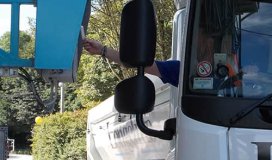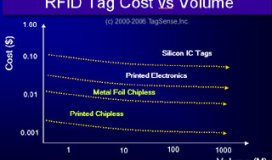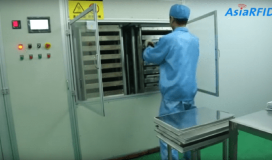Covercraft, a car-cover manufacturer based in Pauls Valley, Okla., is using a Near Field Communication (NFC) RFID solution provided by Shopfloor to help track the clocking-in and movements of operators throughout its plant. The Shopfloor system enables Covercraft to know which tasks were conducted, by whom and when; monitor who was responsible in the event that an error occurs; and pay workers based on the specific quantity of tasks they complete. Several clothing or shoe manufacturers are employing a Shopfloor solution in a similar fashion, with a maker of men's suits also planning to utilize the technology for a consumer-based application.
Shopfloor, based in Alpharetta, Ga., produces wireless shop floor control (SFC) solutions for manufacturers of apparel and other consumer products. By implementing the company's Shopfloor Eye software, in conjunction with NFC RFID technology or QR codes, a manufacturer can automate the collection of work-in-progress (WIP) data. But Shopfloor is now considering a consumer-facing use case for some of its customers. If an NFC RFID tag is incorporated into a product, shoppers could use their Android-based devices, with a Shopfloor app, to access data regarding a particular product, such as where, when and how that item was made. They could also view photographs of the product as it was assembled.
Covercraft, which also makes car-seat and dashboard covers, as well as floor mats and other products, is using the Shopfloor Eye software in conjunction with NFC RFID tags embedded in employee badges and QR codes printed on the products. As an operator begins working at the start of each day, that individual taps his or her badge against the Google Nexus 7 tablet's built-in reader, then scans a QR code printed on each product. That data is stored so that the company can maintain a record of who provided which processes on that product. The information can be used to identify when a machine or operator is not functioning properly, or where bottlenecks occur. The firm is using QR codes rather than NFC tags since they are less expensive when purchased in large volumes.
A Puerto Rican manufacturer of military products is utilizing the Shopfloor Eye software and NFC RFID tags made with Semiconductors' NTAG213 chips to track each pair of shoes through the assembly process, as well as matching that product to the individual workers and machines that carry out the assembly. That data, says Justin Hershoran, a Shopfloor partner, enables inspectors to easily review information, provide their own input and route an item to the repair area, if necessary, before it is sold to the customer.
The company—which has asked to remain unnamed—began using the solution approximately one year ago, and changed its payment model to compensating each employee according to the number of products he or she completed. The new system has since saved about 15 to 20 minutes of each worker's time (which was previously spent filling out paperwork about which tasks were being performed) while employees' productivity has increased by 10 to 15 percent, since they are automatically being paid per task completed.
With the system, every pair of shoes is assigned a traveler—a reusable plastic NFC card that remains with its corresponding product until it is fully assembled. Each machine operator and supervisor is also assigned an NFC-enabled badge that, like the traveler, contains an RFID tag with an NTAG213 chip. The unique ID number encoded to the badge tag's memory is linked to that individual's name and work title in the Shopfloor Eye software, which resides on the company's server.
Once a pair of shoes is prepared for assembly, a traveler card is linked to that product, including the footwear's description and serial number in Shopfloor Eye. The shoes then move through a series of stations to be stitched, glued or trimmed. At each location, a worker is assigned to a specific machine. When the product arrives, the worker uses a Samsung Android-based tablet to scan the NFC tag embedded in his badge, along with the NFC tag in the traveler card. The worker then completes his work on the product, and the Shopfloor Eye software stores that event.
The software can provide that data to the company's management for historical information. This enables the firm to identify how long it takes a specific worker to complete each process.
When a pair of shoes are fully assembled, an inspector looks them over for any errors, such as a seam not having been properly glued. In the event that an error is detected, details about the flaw are input in the Shopfloor system, and pictures are taken to be stored along with the product's tag ID, after which the shoes are forwarded to another operator, who addresses such issues. Once the repair worker receives the footwear, he can read the traveler card, access the inspector's notes and pictures, and quickly complete the repair work. Without the technology, personnel often had to locate the appropriate inspector and ask him to point out the problem.
To see more information can visit rfidjournal.com


